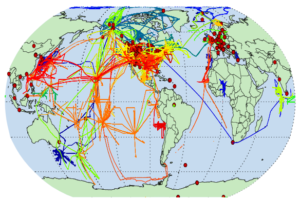Aerosol – cloud interactions
The effect of aerosol on clouds is one of the largest uncertainties in our ability to understand and predict the effect of human activities on climate. In the past decades we have gained significant increases in our understanding of how aerosol and clouds interact, but this improved understanding has not yet resulted in a significant decrease in the uncertainty of the effect of aerosols on clouds.
The aim of GASSP is to reduce this uncertainty by developing the best possible computer model of global aerosol by using extensive observations to test and improve the processes in the model. Such “process-based” improvement of models requires measurements of aerosol microphysical properties such as the particle size distribution, chemical composition and number concentration. These measurements can only be made “in situ” from aircraft, ground stations and ships.
What is unique about GASSP?
Observations are used to constrain the model.
Observations have been used to identify parameter settings that yield unrealistic model results.
GASSP has some unique features that aim to accelerate the improvement of the model and our understanding of how aerosol impacts climate:
- Synthesis of a vast array of diverse aerosol measurements from aircraft, ground stations and ships. Although such observations are routinely used to test models, they are rarely brought together in a single model study. By synthesising different aerosol measurements we can ensure that the model skill is consistent across a range of aerosol properties in a range of environments (GASSP description paper: Reddington et al 2017 ).
- Use of unique model statistical data when comparing against measurements. Fast model emulators enable effectively thousands of model runs covering the uncertainty range of the model processes, where normally only a handful would be used. Variance-based sensitivity analysis enables us to understand the most likely causes of model-observation bias (description paper Lee et al ACP 2011).
- Model constraint. This involves using statistical approaches to identify which settings of the uncertain parameters produce the “best” model from the ensemble. Unlike data assimilation, where the state of the model is adjusted to match observations, calibration identifies the best representation of processes (observational constraint paper Johnson et al ACP 2019).
- Robust identification of biases. GASSP will be able to identify model-observation biases when observations do not lie within the wide model ensemble uncertainty range. Such biases will point towards structural uncertainties related to missing processes or issues related to the host climate model.
- Advice on observational requirements. Field experiments to measure aerosol are costly and time consuming. Within GASSP we are working to determine which observations would be most beneficial in terms of reducing the uncertainty in model predictions.
What models have been used in GASSP?
GASSP uses the Met Office global climate model HadGEM-UKCA. The model includes an advanced treatment of aerosol microphysical processes.
The need to improve estimates of aerosol forcing has led to the development of sophisticated “second generation” aerosol microphysics models in many of the world’s climate models. Models like the one to be used in GASSP are now capable of simulating the principal aerosol quantity that drives the aerosol effects on clouds and climate – cloud condensation nuclei (CCN) concentrations. Cloud drop concentrations and subsequent cloud radiative and dynamical changes are determined fundamentally by CCN. However, IPCC models have so far not included this level of sophistication in their treatment of aerosols, and are therefore not directly constrained by observations of this key aerosol quantity.
The aerosol model is described in a paper:
- Mann GW; Carslaw KS; Spracklen DV; Ridley DA; Manktelow PT; Chipperfield MP; Pickering SJ; Johnson CE (2010) Description and evaluation of GLOMAP-mode: a modal global aerosol microphysics model for the UKCA composition-climate model, GEOSCI MODEL DEV, 3, pp.519-551. doi: 10.5194/gmd-3-519-2010.
- Further information about the model, and the science it has been used for, is available from the Leeds Aerosol Model Research Group, the Oxford Climate Processes group, or the UKCA website.
What measurements will be used in GASSP?
There has been a dramatic increase in the extent and sophistication of aerosol microphysics measurements over the last decade. These data include particle size distributions, number concentrations and size-resolved composition, all of which influence cloud-forming aerosol. However, aerosol microphysics is not observable on a global scale, but only from spatially and temporally sparse aircraft campaigns or ground stations. So the measurements need to be combined in a synthesis.
The basic premise of GASSP is that the community’s considerable investment in novel and advanced aerosol measurements is seriously under-exploited to improve models. The value of these datasets would be greatly enhanced if they were compiled in a consistent way and exploited in a concerted model evaluation exercise.
GASSP brings together an advanced global aerosol model with these rich datasets to test our understanding of aerosol, and thereby reduce the uncertainty in forcing.
More information about aerosol measurements in GASSP.







